Day 43: Harris's hawk, Parabuteo unicinctus
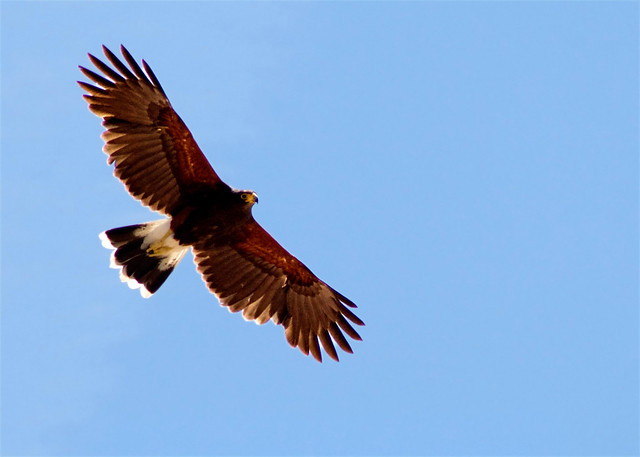 Almost all raptors are solitary hunters. Not the Harris's hawk. Gosh, that spelling looks funny. It's the preferred spelling, though. If you know me, you should be utterly unsurprised to hear that I went to great lengths to check the spelling. Apparently, John James Audubon named it in honor of his friend, Edward Harris, which totally makes me want to strategically befriend some biologists.
Almost all raptors are solitary hunters. Not the Harris's hawk. Gosh, that spelling looks funny. It's the preferred spelling, though. If you know me, you should be utterly unsurprised to hear that I went to great lengths to check the spelling. Apparently, John James Audubon named it in honor of his friend, Edward Harris, which totally makes me want to strategically befriend some biologists.The Harris's hawk hunts in packs, usually consisting of two or more related hawks. This hawk and his companion (she was slightly larger, which female hawks are) were hunting off the side of the road just outside of Apache Junction.
Harris hawks are deep chocolate-brown, with rust-to-chestnut patches on their shoulders. Their species name, unicinctus, means "once girdled" and refers to the band on the tail, but always kind of makes me giggle anyway. Juvenile Harris's hawks are streaked in a buff yellow-brown, and lighter in color than adults.
The weirdest habit these guys have is what's informally known as toteming, where they will stack themselves on one another (like a totem pole). I totally thought this was a myth, until I heard the fourth or fifth biologist speak about it. According to those who know raptors better than I, if there is only one saguaro suitable for resting while scouting for food, one Harris's will perch, another will perch on its back, and another on its back. So if you're ever in the car with me and I shriek with excitement, abruptly pull over, grab my camera and leap out of the car, now you know why.
Day 44: Costa's hummingbird, Calypte costae
 These guys are tiny, but gorgeous. You can tell a male Costa's apart by the purple gorget, which flares out distinctively when he bends his head. The flash when he turns his head just right is absolutely gorgeous. Female Costa's are plainer, but their smaller size, gray cheeks, and white eye marks. Costa's are only about three-and-a-half inches long, and have very short tails, which are overlapped by their folded wings when they perch.
These guys are tiny, but gorgeous. You can tell a male Costa's apart by the purple gorget, which flares out distinctively when he bends his head. The flash when he turns his head just right is absolutely gorgeous. Female Costa's are plainer, but their smaller size, gray cheeks, and white eye marks. Costa's are only about three-and-a-half inches long, and have very short tails, which are overlapped by their folded wings when they perch.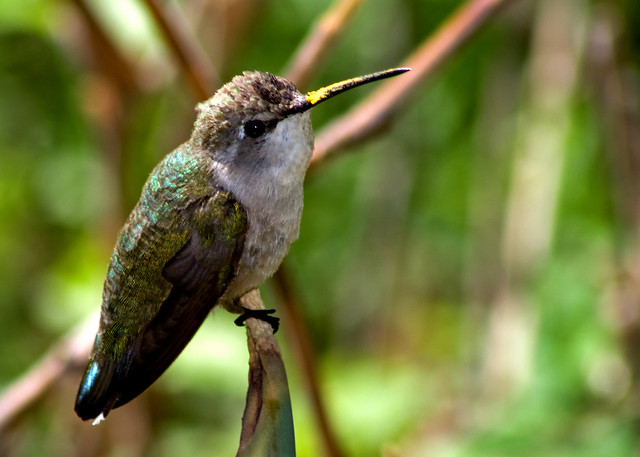
They're tiny, but these little birds hold their own. They don't call out as much as the Anna's, but Costa's are territorial. These two competed with a couple of broadbills and a garden full of Anna's, and still managed to get a good dose of feeder nectar as well as stuff from the original source, as you can tell from the pollen on the female's bill.
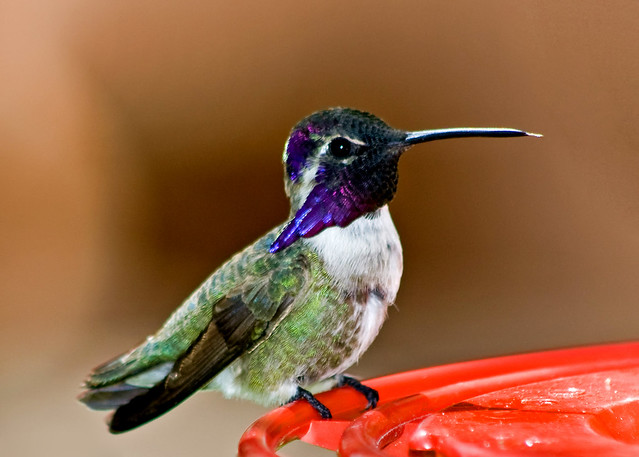
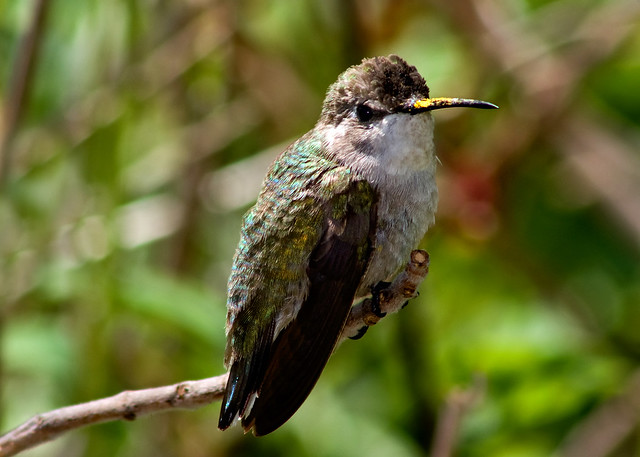

Day 45: Canada goose, Branta canadensis
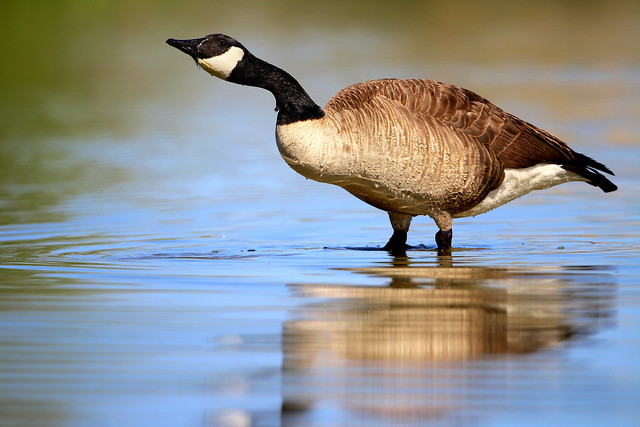 Obviously from their name, not strictly a regional bird, but I like to mix it up between Arizona Animals™ and ones with a wider range. Mostly Canada geese are snowbirds in Arizona. Like snowbirds of the human variety, they have been known to stick around if they decide they like the food and mild climate here. (Unlike snowbirds of the human variety, there is little problem with geese driving 45 miles an hour on the freeway with their hazard lights on.)
Obviously from their name, not strictly a regional bird, but I like to mix it up between Arizona Animals™ and ones with a wider range. Mostly Canada geese are snowbirds in Arizona. Like snowbirds of the human variety, they have been known to stick around if they decide they like the food and mild climate here. (Unlike snowbirds of the human variety, there is little problem with geese driving 45 miles an hour on the freeway with their hazard lights on.) We mostly see Canada geese throughout the winter, sometimes right through to mating and raising families. Adult geese molt their primary flight feathers while raising young, leaving the whole family flightless for a brief period. They are monogamous, and great parents. The male will sit as sentinel, chasing and hissing at anyone who gets near his young. And if you've ever heard the obnoxious honking they do when just flying from one place to another, you can imagine how they can turn it up when they're really mad.
We mostly see Canada geese throughout the winter, sometimes right through to mating and raising families. Adult geese molt their primary flight feathers while raising young, leaving the whole family flightless for a brief period. They are monogamous, and great parents. The male will sit as sentinel, chasing and hissing at anyone who gets near his young. And if you've ever heard the obnoxious honking they do when just flying from one place to another, you can imagine how they can turn it up when they're really mad.Day 46: Turkey vulture, Cathartes aura
 Ah, turkey vultures. You know how I feel about these guys. (Read here.) What else can I say? Well, plenty. But mostly, read that. And just watch them. Grace. Purity. Beauty (yes, really). Certain aviation techniques were designed after the Wright brothers watched the way turkey vultures glided, and decided the birds had it exactly right. It's not hard to see why.
Ah, turkey vultures. You know how I feel about these guys. (Read here.) What else can I say? Well, plenty. But mostly, read that. And just watch them. Grace. Purity. Beauty (yes, really). Certain aviation techniques were designed after the Wright brothers watched the way turkey vultures glided, and decided the birds had it exactly right. It's not hard to see why.You know what? I totally think we need some more turkey vultures.
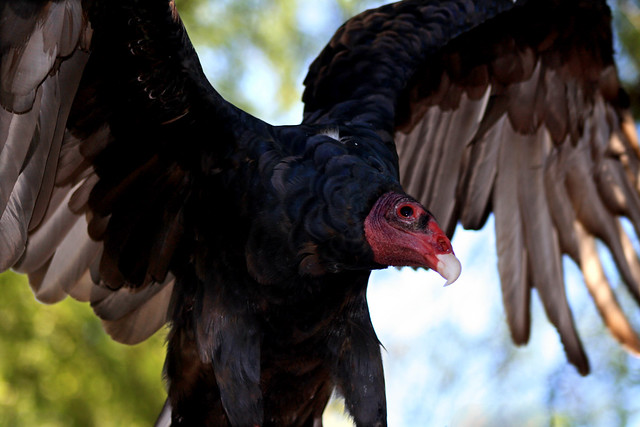
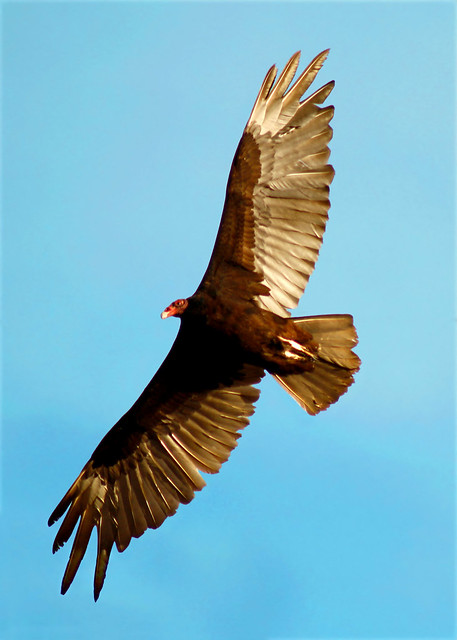

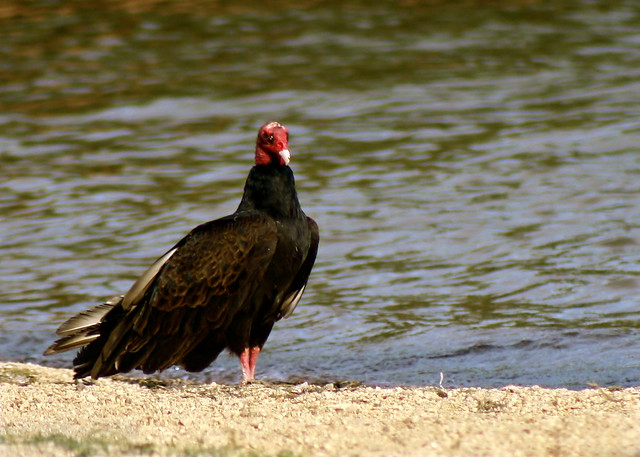
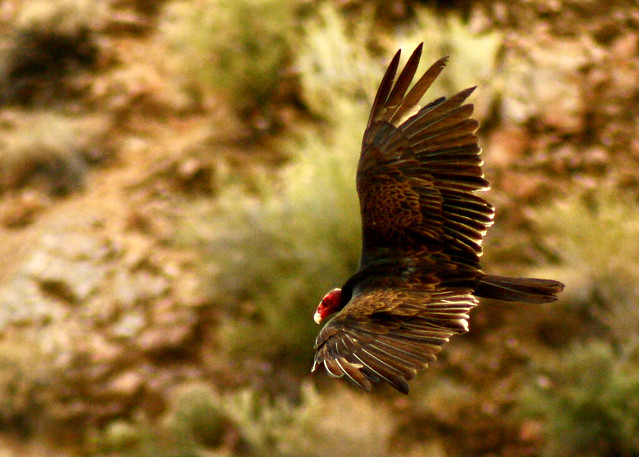

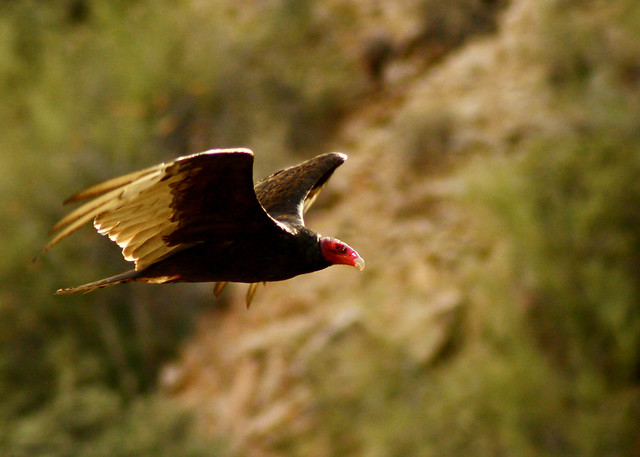
Day 47: American wigeon, Anas americana
 I haven't seen this one nearly as often as many other ducks, but it's always a treat when I do. Wigeons are common migrants and winter residents in Arizona, and there have been records of them breeding in the White Mountains area. The male of this species has a white cap, giving the species the nickname "baldpate." (He also has brilliant green streaking back from each eye.)
I haven't seen this one nearly as often as many other ducks, but it's always a treat when I do. Wigeons are common migrants and winter residents in Arizona, and there have been records of them breeding in the White Mountains area. The male of this species has a white cap, giving the species the nickname "baldpate." (He also has brilliant green streaking back from each eye.)The weirdest thing about this one? She growled. Crazy. I didn't know ducks growled.
Day 48: Lowland leopard frog, Lithobates yavapaiensis
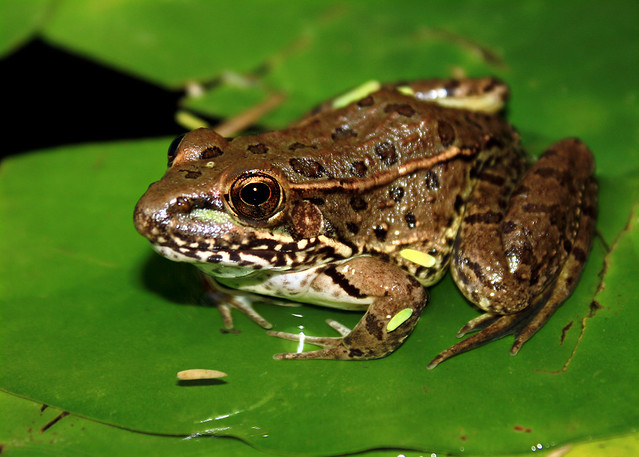 Credit goes to Cascavel1 (also known as Brendan) for the ID on this one. I am really rusty on amphibian identification most of the time, mostly because they've always been so rare that at the time of sighting my analysis only goes as far as "Holy cow; a frog!" (On the other hand, rattlesnakes and spiders of all kinds are common enough that I can identify scores of species of each on sight. It's all what you're used to.)
Credit goes to Cascavel1 (also known as Brendan) for the ID on this one. I am really rusty on amphibian identification most of the time, mostly because they've always been so rare that at the time of sighting my analysis only goes as far as "Holy cow; a frog!" (On the other hand, rattlesnakes and spiders of all kinds are common enough that I can identify scores of species of each on sight. It's all what you're used to.)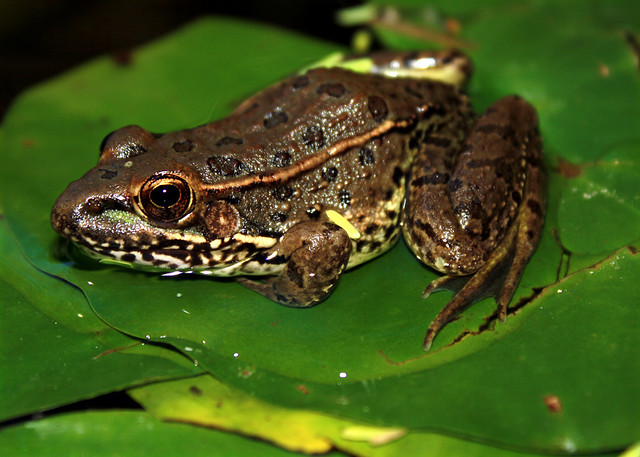 This guy is pretty small, just a little over three inches, barely larger than its tadpole form. They're usually brown and mottled, have ridges (dorsolateral folds) that break up toward the rear, and have a yellow wash to their groin. (Now can you see why I have a hard time IDing frogs?) They have a decent range in central Arizona, though they used to range from the lower Colorado River, east through central Arizona below the Mogollon Rim and southeastern Arizona, and into New Mexico. They are being displaced by other species, though they have held out better than the Chiricahua leopard frog, presumably because they're better at breeding. (I'm sure that's the line used by every male lowland leopard frog.) They're especially active near washes during the monsoon season.
This guy is pretty small, just a little over three inches, barely larger than its tadpole form. They're usually brown and mottled, have ridges (dorsolateral folds) that break up toward the rear, and have a yellow wash to their groin. (Now can you see why I have a hard time IDing frogs?) They have a decent range in central Arizona, though they used to range from the lower Colorado River, east through central Arizona below the Mogollon Rim and southeastern Arizona, and into New Mexico. They are being displaced by other species, though they have held out better than the Chiricahua leopard frog, presumably because they're better at breeding. (I'm sure that's the line used by every male lowland leopard frog.) They're especially active near washes during the monsoon season.Day 49: Greater yellowlegs, Tringa melanoleuca
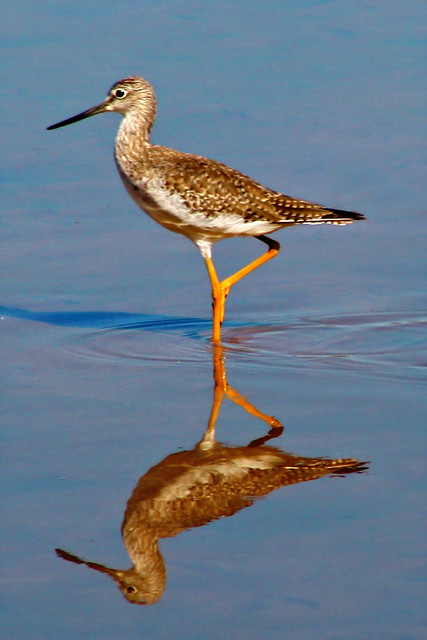 Pretty easy to identify, with their mustard-colored legs. The only trick is telling greater yellowlegs from lesser yellowlegs. If they're not side-by-side for a size comparison, one trick is to check the bill: a greater yellowlegs' bill is noticeably longer than the head, and sometimes slightly upturned. These guys are pretty timid, prancing or flying away with a scolding tew-tew-tew if I get too close.
Pretty easy to identify, with their mustard-colored legs. The only trick is telling greater yellowlegs from lesser yellowlegs. If they're not side-by-side for a size comparison, one trick is to check the bill: a greater yellowlegs' bill is noticeably longer than the head, and sometimes slightly upturned. These guys are pretty timid, prancing or flying away with a scolding tew-tew-tew if I get too close.That's it this week! What've you seen lately? I got two e-mails to identify spiders, one for a dragonfly, and one for a hawk this week, so I know you're looking!
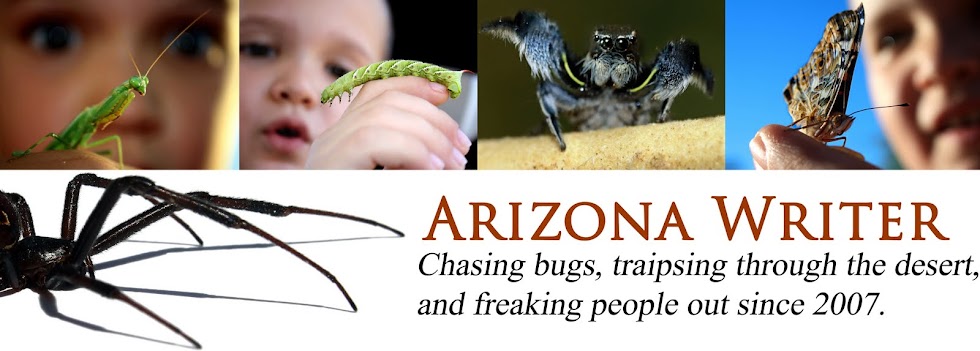
3 comments:
Wow, these are BEAUTIFUL pictures! I'm excited about following your blog!
Awww, thank you! So happy to see you here.
Very beautiful pictures! good work
Post a Comment